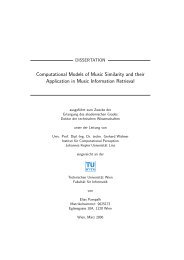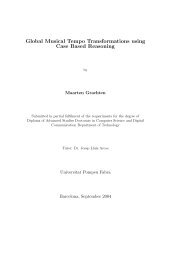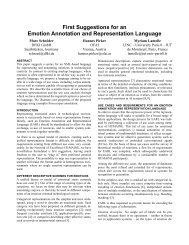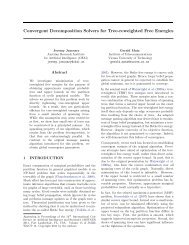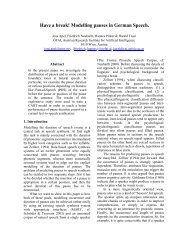A HYBRID MODEL OF REASONING BY ANALOGY
A HYBRID MODEL OF REASONING BY ANALOGY
A HYBRID MODEL OF REASONING BY ANALOGY
Create successful ePaper yourself
Turn your PDF publications into a flip-book with our unique Google optimized e-Paper software.
process as deduction, induction or analogy. In this way we can view the analogy case as the most<br />
general one with deduction and generalization at the two extremities - where the retrieved source<br />
and the target are related in a specific way, one of them happening to be a particular instance of the<br />
other.<br />
Many researchers who model analogy separately suppose that, in the course of the reasoning<br />
process, an explicit decision to use analogy is made at the beginning, thus causing the application<br />
of the method of reasoning by analogy. For example, Wolstencroft (1989) states explicitly that if<br />
we use one method in preference to any other one we should have identified in advance that the<br />
chosen method will be the most likely to offer a solution and that is why he adds an identification<br />
step to his model. In contrast with the above, I assume that typically the reasoning mechanism<br />
starts with its retrieval process and it is the result of the retrieval process which determines, at a<br />
later stage, the kind of reasoning used. Burstein & Collins (1988), Collins & Michalski (1989),<br />
analyzing a set of protocols, also came to the conclusion that the kind of knowledge retrieved from<br />
memory drives the particular line of inference produced.<br />
The present work is a part of a broader project aiming to elaborate and test the hypothesis about the<br />
uniformity of human reasoning. A uniform mechanism of human reasoning in a problem solving<br />
task, called Associative Memory-Based Reasoning (AMBR), has been proposed (Kokinov,<br />
1988b) and some experimental data supporting it has been obtained (Kokinov, 1990). As it is still<br />
in progress, in the current presentation I will concentrate on the way AMBR models analogical<br />
reasoning, in spite of the fact that part of the considerations might be valid in other cases as well.<br />
2. PSYCHOLOGICAL PHENOMENA TO BE <strong>MODEL</strong>ED<br />
The general phenomenon to be modeled is that people do solve problems by analogy. This is, of<br />
course, well known from numerous experiments as well as from everyday life. We need,<br />
however, much more detailed information about the way people do it, which factors influence<br />
human performance and in what manner, what kind of accompanying phenomena can be observed.<br />
There is a considerable shortage of psychological experiments that could provide answers to these<br />
questions, but there is some experimental data to be taken into account when modeling human<br />
analogical problem solving.<br />
Analogical problem solving can be initiated by an explicit hint to use a particular case (provided by<br />
a teacher) as a source for analogy (Gick & Holyoak, 1980, 1983), by a reasoner's explicit decision<br />
to try to solve a difficult problem by an (a priori unknown) analogy and generating (constructing)<br />
various sources by systematic transformations (Polya, 1954, 1957, Clement, 1988), or by<br />
spontaneous retrieval of a source from memory and noticing the analogy between this case and the<br />
target. In the present work only the last case is investigated: the spontaneous use of analogy.<br />
It is a well known experimental fact that people usually have difficulties retrieving spontaneously a<br />
source analog, especially an interdomain analog (Gick & Holyoak, 1980, 1983), and this is<br />
probably the main difficulty in human analogical problem solving. However, Holyoak and Koh<br />
(1987) demonstrated that spontaneous analogical transfer in fact occurs even between remote<br />
domains like the Radiation Problem (Dunker, 1945) and a lightbulb story. Experiments performed<br />
by various researchers (Gilovich, 1981, Ross 1984, 1987, 1989a, 1989b, Gentner & Landers,<br />
1985, Holyoak & Koh, 1987) demonstrated clearly that the main factor affecting the retrieval<br />
process is the semantic similarity between source and target, i.e. the number of shared features.<br />
Two different classifications of features as structural and superficial have been put forward in the<br />
relevant literature: sometimes the former are defined as causally related to possible solutions and<br />
the latter as features unrelated to any solutions, and sometimes the former are defined as n-ary<br />
predicates, especially the higher-order ones, and the latter as unary first-order predicates. It was<br />
shown that superficial features (in both classifications) have considerably greater influence on the




